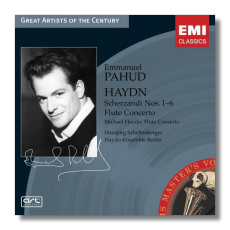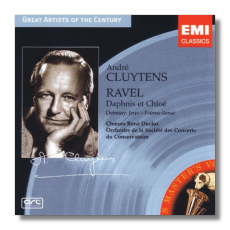
The Internet's Premier Classical Music Source
Related Links
- Latest Reviews
- More Reviews
-
By Composer
-
Collections
DVD & Blu-ray
Books
Concert Reviews
Articles/Interviews
Software
Audio
Search Amazon
Recommended Links
Site News
 CD Review
CD Review
Great Artists of the Century

- Franz Joseph Haydn: Scherzandi #1-6, Hob II/33-38
- Michael Haydn: Flute Concerto in D Major
- Leopold Hofmann: Flute Concerto in D Major
Emmanuel Pahud, flute
Haydn-Ensemble Berlin/Hansjörg Schellenberger
EMI Classics 476864-2 DDD 79:30
[ Replaces EMI CDC556577-2
Amazon
- UK
- Germany
- Canada
- France
- Japan
- ArkivMusic
- CD Universe
]


- Maurice Ravel: Daphnis et Chloé
- Claude Debussy: Jeux
Choeurs René Duclos
Orchestre de la Société des Concerts du Conservatoire/André Cluytens
EMI Classics 476854-2 ADD 73:19
These two releases are from EMI Classics' "Great Artists of the Century" series. The Pahud disc presents a young artist who, in many ways, is just getting started. The Cluytens disc, on the other hand, honors a musician who died in 1967, three years before Pahud was even born. Both discs present the artists in music which, while it suits them extremely well, is not the most obvious choice – and three cheers for that! I welcome hearing Pahud in something other than the Mozart Flute Concertos and Cluytens in something besides Berlioz's Symphonie fantastique.
As he was born in 1970, perhaps it is a little premature to refer to Emmanuel Pahud as one of the "Great Artists of the Century" (which one?). At the same time, there's not a single Pahud CD that has come my way that is anything less than outstanding. Clearly, he is this century's successor to Jean-Pierre Rampal, both in the excellence of his technique and in his stylistic adaptability. Also like Rampal, he is willing to explore other genres. In 2001, he and pianist Jacky Terrason recorded Into the Blue for EMI Classics (5 57257 2), an intriguing album in which composers such as Vivaldi and Schumann were given the jazz treatment. In no way was Pahud shown up by his jazz colleagues.
The present CD was a clever one to select for reissue – why shouldn't EMI give listeners something beguiling and relatively unfamiliar to associate with Pahud? The music on this CD is hardly overplayed, and while it deserves attentive listening, it can enrich any task you are performing around the house or in the automobile. Joseph Haydn's Scherzandi are bite-size symphonies in four movements, each seven or eight minutes in length. Haydn probably wrote them for Esterháza in the early 1760s. The solo flute really comes into its own only in the Menuets (in their Trios, specifically). Haydn once was credited with the D-major Flute Concerto which closes this disc. Recent scholarship suggests that it really is the work of one Leopold Hofmann, a contemporary of Joseph Haydn who earned the more famous composer's scorn for believing that "he alone had ascended the heights of Mount Parnassus." (A tip of the hat to Richard Wigmore's booklet notes for that quote!) The concerto by Michael Haydn, Joseph's brother, is hardly different in style than Hofmann's. What all of the music on this CD has in common is galant charm that just doesn't quit, and relaxed but committed advocacy from Pahud and his fellow musicians. The engineering lends the proceedings all due warmth. This is one not just for flute fanciers, but for those who like their music to be on the polite and gracious side.
The flute figures prominently in Ravel's Daphnis et Chloé, of course, and I'm sure that Pahud has played its solos many times, including during his tenure with the Munich Philharmonic, when the late Sergiu Celibidache was its music director. Pahud wasn't alive, however, in 1962, when André Cluytens recorded Ravel's complete ballet for EMI. That particular recording was not among those that EMI reissued a few years ago in their Ravel/Cluytens compilation (5 66905 2). It was left to Testament to license the recording from them, but now EMI has reissued it themselves, and at a fraction of Testament's price.
It often is assumed that Cluytens was French, but he was born in Belgium, and he did not become a French citizen until he was in his 40s. I'd like to think that Cluytens's Belgian motherland instilled a sensitivity for classical proportion in the conductor. Four decades later, his Beethoven symphony cycle still has much to offer. Likewise, his Daphnis is characterized by precision, and by concern for form, attributes which seem more Germanic than French. All the ballet's color and opulence are there, but this is not a reading where the music simply proceeds from one spectacle or effect to the next. Another attraction is the sui generis sound of the Orchestre de la Société des Concerts du Conservatoire. Back in the 1960s, all orchestras did not sound alike – how things have changed in 40 years! – and Cluytens's orchestra had a lean, athletic quality, with somewhat nasal brass and throbbing woodwind timbres. It's not as lush as the Berlin or Vienna Philharmonics, for example, but it is very appropriate for Ravel's score. In a competitive field, I would not say that Cluytens's Daphnis is "the best," but it is among the best, and it will satisfy everyone except those who seek a more obviously sumptuous presentation of the ballet. Jeux, Debussy's "two girls, one boy, and a tennis ball" ballet can be a hard sell, but you wouldn't know it from Cluytens's exciting recording from 1963. If everyone conducted it as passionately as he did, it would be a more popular score.
The digital remasterings date from 2001 (Daphnis) and 1993 (Jeux), and they give first-class results.
Copyright © 2005, Raymond Tuttle




















